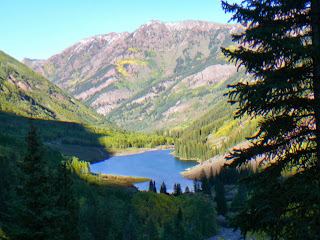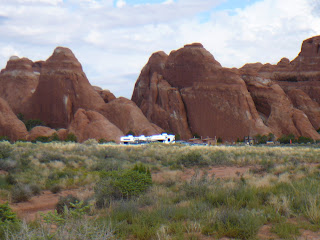We next visited the Natural Bridges Monument, still in southern Utah. How bridges and arches differ you may want to know. Natural bridges are formed by the erosive
action of moving water. Arches are
formed by other erosional forces, mainly
frost action and seeping moisture. Those
same forces also work to enlarge natural bridges once stream erosion forms
them.
Natural Bridge National Monument is a small park containing
three of the world's largest natural stone bridges. Sipapu
Bridge, Kachina Bridge and Owachomo Bridge - all are Hopi Indian names. The 9
mile long one way Bridge view loop road runs right around the park and leads to
overlooks and trailheads right down to
the bases of each of the three bridges on the canyon floor.
The photos above are of Sipapu Bridge, firstly from the roadside and then from the canyon floor. The walk down to Sipapu Bridge was not a long
one - about 1.5km but it was VERY steep with ladders and handrails over the
steep rockface to get to the canyon floor.
Owachomo Bridge from the roadside. This bridge no longer straddles a stream whereas it was originally cut by the action of two streams. It is really an arch now as the water presence has disappeared.
and at the foot of the bridge on the canyon floor.
Newspaper rock is an art panel which represents multiple
cultures, some of the carvings dating back some 1500 years while others were
placed there at the turn of the 20th century; The images on this large rock face are
petroglyps.
The photo above is of the Goosenecks of the San Juan River. The 1,000ft (305m) cliff rises above one of the most striking examples of an entrenched river meander in North America. The river twists and turns through sinuous 'gosenecks' as it advances west on its journey to Lake Powell flowing over 6 miles (10km) while it advances to the west only 1 mile (1.5km).
We stopped for the night on the cliff top where we took the photograph. These campers camped on the ledge below.
Our last stop in Utah this time around was at Hovenweep National Monument which preserves the dwellings of the ancestral Pueblo people. Here are two style of houses.



















































